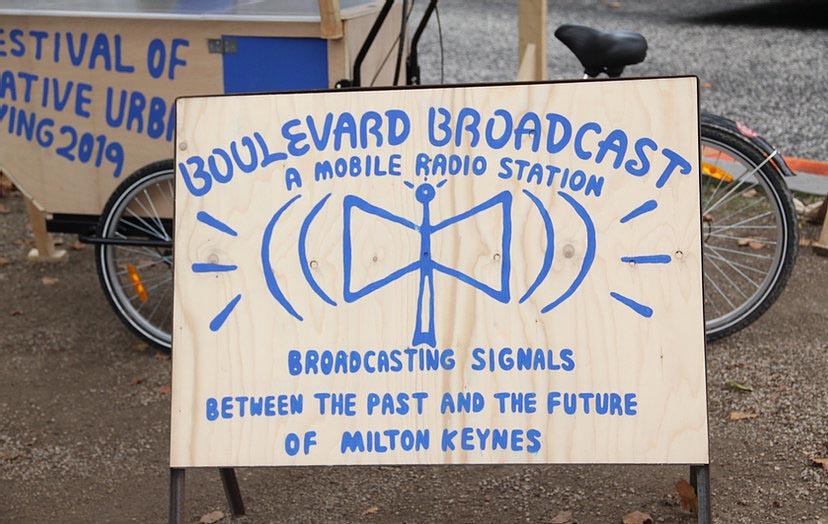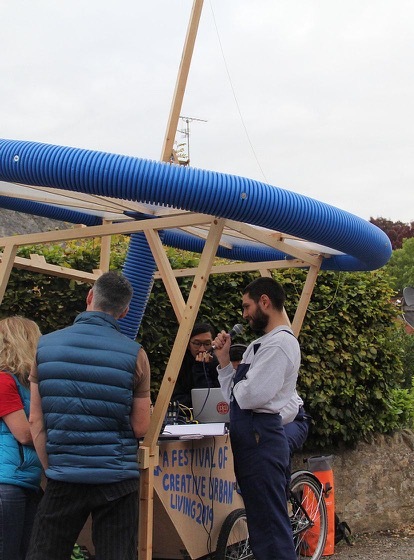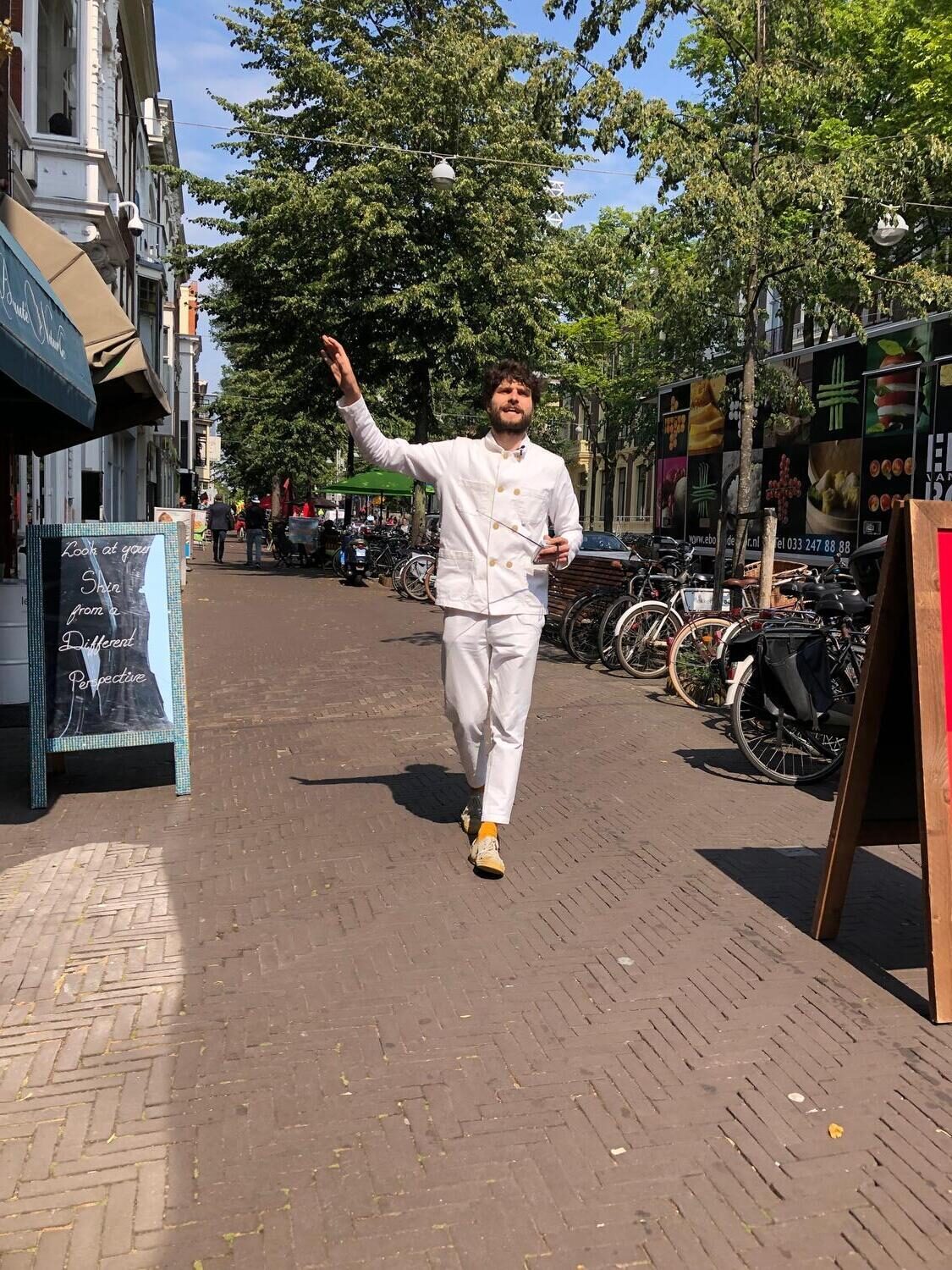Jack Bardwell
Outside of INSIDE - Portraits of alumni
For their self evaluation report in 2021, INSIDE conducted interviews with alumni who, in one way or another, represented the different positions on the bandwidth and generations of alumni. The interviews were conducted by the head of the department who also wrote their reports. These reports were submitted to the interviewees for approval after which they could add comments.
Jack Bardwell (graduated 2019) grew up in London and did a bachelor in graphic design in Falmouth, Cornwall. Before coming to INSIDE, he worked for several years mainly on exhibition design projects.
He now profiles himself as a designer and artist working across the disciplines of graphic design, installation and spatial change. https://jackbardwell.com
In his graduation project The School within The School Jack designed a parallel art academy to our Royal Academy of Art for an empowered community of students within the Academy, as a permanent starting point for the schools transformation. After graduation, at the invitation of INSIDE, he designed an Inter-Masters programme for student exchange on their graduation development called Group Therapy, which is now in its second season.
After graduation, he also participated in the raumlaborberlin project 'Creative Urban Living' in Milton Keynes, England. In collaboration with 'no purpose', a collective of INSIDE alumni from 2015-2019, he participated in an open call after which they were invited by the city council.

For a two-week period, they created a mobile radio station that was essentially a combination of his graduation project and that of Daniele Valentino, a fellow student. The mobile radio station is a research method for getting in close contact with the community. "That was the first project I did outside of INSIDE."
Furthermore he is also doing things that are mostly education-related and "organisational stuff like creating frameworks for other people to work within or create", but less about making a spatial intervention with its own identity and presence.
A driving force behind his projects after the academy is radio, one of the tools he developed for his graduation project to create a place as a "medium for other people to speak". In his research, he observed an urgent need among students to exchange views on the growing criticism of the culture of the institution.
Especially in times of corona, when everyone had to keep a distance from each other, radio proved very suitable for this. His 'Mushroom Radio' is still being used at the KABK and also earned him an invitation to a workshop at the Design Academy Eindhoven and an invitation from the Future Architecture Platform to Croatia. In addition, he hosts a weekly radio programme for Pension Almonde, a project by INSIDE practice tutor Erik Jutten in Rotterdam, and in the summer of 2021 he will take part in 'The Waterschool' by Studio Makkink&Bey as part of the Rotterdam Architecture Biennale. Jack says he started with radio "out of restrictions, but meanwhile it has proven its value as a community creating tool".
But what is the relationship of radio to spatial change?
First of all, for Jack it is "a tool for understanding how space is used." He started using radio because during his studies he "also questioned the visual representation of architecture. That it is always represented through drawings or through imagery. Especially on platforms like Instagram there is very much a focus on how buildings look, icons of buildings."
In contrast, he says, INSIDE's approach is not to look at architecture as an image, but to look at the social and cultural implications of architecture and space. "Audio platform and recording is about how people are living and using the space. And by focussing purely on audio in that way, you can capture the atmosphere and how people are using the space before you think about the aesthetics of how things look. It tells a different story when you can't see it."
His project in Milton Keynes, too, may have been a mobile radio station, but at the same time it was very much about the built environment. "We created a spatial intervention that was mobile and that was also about aesthetics. It caught a lot of attention and broke down barriers for people to open up to us and tell their stories".

In this way, they collected a lot of stories, opinions and proposals for changing the city. And what was the output? The project did not end with designs for the city by 'no purpose'. Nevertheless, there was a lot of output that can play a role in a future spatial change of the city. First of all there was the performative act with the mobile radio in the city with which they realised intense moments of reflection with residents. The recordings of these moments were broadcasted on a local radio station. In addition, there was also a final parade through the city where the collected ideas were carried and also processed into a future model by other participants in the festival.
The project in Milton Keynes consisted a lot of communicating and archiving and mainly caused awareness by "creating a space to imagine things being different to the dominant narratives." Within this, the radio worked as a tool to initiate continuous change, but not to take control of how these proposals would eventually be transformed spatially.
What role has INSIDE played in shaping his approach?
Jack says that "the attitude of going and acting and seeing what the reactions are from that process, and not being shy to go out and try things, is something I got from INSIDE". It is about working with first-hand information and realising that the action of gathering that information, the research tool, is part of the process, as an event for example. His projects research and activate at the same time, they are a tool to gather knowledge and to influence how people perceive their living environment.
The spatial design lies in the event, like the design of the mobile installation in Milton Keynes for example. When he used the radio at the KABK, he could build on the fact that he himself was part of that context, but in Milton Keynes he was a stranger and could not pretend to be part of the community. The designed installation created a new place in that context for new relationships.
Jack cannot say whether INSIDE prepared him for his current position. According to him, this is not possible because it would imply that the position was known and the necessary skills for it would have been predictable. Rather, Jack sees it as INSIDE having put him on the path to this position. He appreciates that INSIDE opens the way to different positions in designing space but still sees room for improvement. For example, he was already more aware than his fellow students in his year group of the position he was aiming for within the bandwidth INSIDE opens up.
As a result, part of the programme from the first year was of limited inspiration to him. He found it regularly too assignment-oriented and too little open to other perspectives on the core situations. He would have preferred a more open studio situation. A specific tutor who introduces her or his design vision as a starting point, but subsequently opens a context in which the students can develop their own views. The tutor then reflects on this from his or her own vision of the built environment.
INSIDE could also more explicitly open the way to information, discourses and communities that represent different positions on the bandwidth. All these positions do not have to be hard-wired into the programme, but encounters with them can be organised in the form of lectures and workshops. Jack emphasises that this is a possible improvement because he found the meetings and the information he experienced at INSIDE good and interesting. He was particularly impatient to get fully started in his preferred direction.
Besides his wish for a more open programme, he also appreciated the super-concrete workshops: "specific skills you get to know for some days, and then you can decide on the applicability", and the travel programme: "meeting people in different contexts doing similar things", which he enjoyed very much.
He did not always find it easy to work with fellow students who had very different ideas about working on the built environment. It became a learning experience for him because he often missed active engagement in his peer group, which led him to look for like-minded people within the KABK for his graduation project.
The sociocratic organisation model that studio practice tutor Erik Jutten introduces every year was an eye-opener for Jack. He discovered a tool for setting up fruitful collaborations with people who think in a completely different way. However, Jack does not want to advise eliminating those differences in the student group by striving for a more unified group.
Differences in culture, gender, age and portfolio are good, but that variety "needs to feed into the culture you are trying to create within INSIDE." Jack recommends recruiting new students based on the specific views of INSIDE and testing the potential students on these. Less selecting on the basis of similar portfolios, and more looking at what lies beneath the surface of their work, such as criticality and the ability for self-expression. "If that is strong, it can be looked for in a variety of disciplines." And Jack recommends involving current students in the selection process, because he thinks they are better able to recognise precisely those qualities.
Finally, Jack has no specific recommendations for INSIDE, but he shares his thoughts. He thinks the way INSIDE presents itself on Instagram is not very exciting. He recommends becoming more active on social media because those are the places where students orient themselves. "Then I think you would attract more people that are engaged in the things you want people to be engaged in."
He does not support the division of positions within the bandwidth into separate programmes; creating more choice in the programme and better guidance to specific information suffices. Despite the fact that his work, especially with radio, seems far removed from the classical architectural profession, he is happy with architecture in the master's degree title.
In addition to all the aforementioned activities, he is also working with a group of designers he worked with before INSIDE. Under the name 'Everyday Fictions', they are participating in open calls for spatial design projects and exhibition design. A master's degree in interior architecture certainly comes in handy then.
